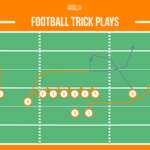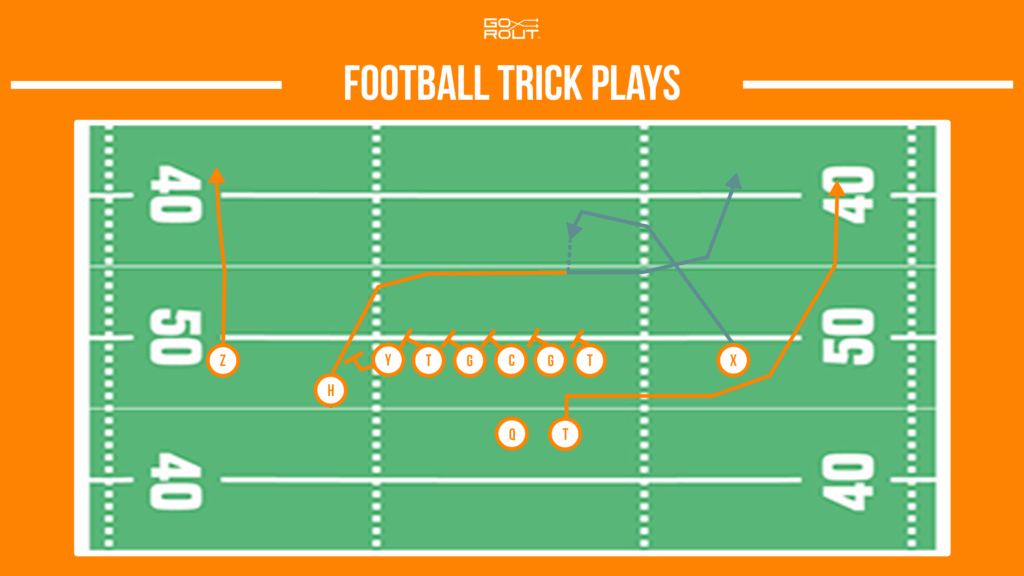How to Draw Football Plays: A Complete Guide for Coaches
Reading Time: 11 minutes
Reading Time: 11 minutes
Drawing football plays seems easy at first glance, but it’s more than scribbling X’s and O’s.
To draw plays, football coaches map out player positions, routes, and blocking assignments in a way that shows exactly how the play should unfold.
When you learn how to draw football plays, the process turns your strategy into a visual plan that players can follow.
It’s a bridge between your ideas and what happens on the field.
In this guide, you’ll see how to draw routes, set blocking schemes, and use platforms like GoRout Scout to keep everything organized and boost the team’s results.
Why Football Play Diagrams Matter
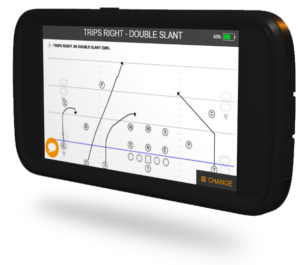
Football play diagrams give you a clear way to visualize how a play should work. Instead of long explanations, you can use symbols and arrows to map out each player’s job.
Diagrams support offense, defense, and special teams. Each group benefits from seeing assignments drawn out, making practice smoother and execution more reliable.
It makes teaching, learning, and remembering plays easier.
Organizing plays with digital tools lets experienced coaches adjust strategies for different opponents. That kind of prep gives your team a winning edge.
Key reasons diagrams matter:
- They simplify complex strategies
- They improve communication between coaches and players
- They help college and youth teams compete at higher levels
- They allow quick adjustments during a game
For more on coaching methods, check out USA Football for advice on play design and teaching strategies.
The Foundational Elements of Football Plays
In football, whether at the youth, high school, college, or professional level, much of the game’s outcome depends on how well a team uses formations.
Below is a detailed breakdown of key offensive formations, defensive fronts, and guidance on how coaches or teams can select the best one depending on personnel, the opponent, and situational factors.
Offensive formations
| Formation | Key Characteristics | Strengths | Weaknesses / Considerations |
| I-formation | QB under center; two running backs behind (fullback + tailback); usually tight end(s). | Excellent for power running; strong lead blocking; good for play-action passes. | Less horizontal space; defense can stack up; not ideal for faster passing concepts. |
| Spread formation | Multiple receivers wide; lighter backfield; stretches defense across width and depth. | Opens passing lanes; creates favorable matchups; good for fast tempo. | Run games may suffer; protection must be solid; pressure can be heavier. |
| Shotgun formation | QBs set several yards behind center; RBs beside or behind; many passing plays. | Better vision for QB; quicker reads; helps in passing game and tempo. | Snap exchange risk; less downhill power; pass rushers have clearer paths. |
| Pistol formation | Hybrid: QB closer than shotgun, running back directly behind; mix of run + pass. | Keeps run threat; better handoffs; maintains many benefits of shotgun. | Some loss of separation; complexity in scheme; needs strong execution. |
| Singleback | One running back; no fullback; more receivers or tight ends; can be under center or in shotgun. | Versatile balance between run & pass; adapts to personnel; flexible in matchups. | Less power in short yardage; fewer blockers; protection depends on skill of receivers. |
| Twins | Two receivers lined up on the same side (“twins side”); unbalanced receiver distribution. | Can overload one side; forces defensive adjustment; creates mismatches. | Weak side may be exposed; predictable if overused; receiver talent important. |
| Trips | Three receivers on one side of the field; heavy receiver presence in that direction. | Strong passing threats; stresses zone or man coverage; allows route combinations. | Less balanced; depends on good receivers; run game can be challenged; protection needed. |
Defensive fronts
| Defensive Front | Key Characteristics | Strengths | Weaknesses / Considerations |
| 4-3 Defense | Four down linemen, three linebackers, plus defensive backs. | Strong run stopping; simpler gap responsibilities; reliable pass rush from front. | May be stretched by spread offenses; linebackers need good coverage ability. |
| 3-4 Defense | Three linemen (including a nose tackle) and four linebackers. | Flexibility in pressure disguise; more varied linebacker roles; strong vs outside runs or pass. | Linemen must hold up vs double teams; interior runs can exploit weak gaps. |
| 4-2-5 (Nickel) | Four linemen, two linebackers, five defensive backs. | Better coverage vs multiple receiver sets; more speed in secondary; adapt to pass heavy offenses. | Run defense can be exposed; DBs must be physical; fewer big bodies up front. |
| 3-3-5 Stack | Three linemen, three linebackers, five defensive backs; linebackers “stacked”. | Great flexibility vs spread; confused fronts; strong coverage options; speed. | Vulnerable to powerful inside running; needs disciplined players; less mass up front. |
| 46 Defense | Heavy box: many defenders near line; safety plays near box; unique alignment to overwhelm offense. | Very disruptive; forces offense to account for multiple rushers; strong against two-back, tight formations. | Leaves deep zones lighter; quick passes and spread can take advantage; requires strong personnel. |
How to choose a formation
- What do your players do well? Choose a formation that matches their strengths.
- What do your opponents do poorly? Choose a formation that forces them into bad matchups.
- Consider the situation (e.g., down and distance, field position, score, time left)
- Don’t be weak in one area just because you want to be strong in another.
- Mix it up so your tactics don’t become predictable.
- Be prepared to change during the game if what you’re doing isn’t working.
How to Assign Player Roles

Assigning player roles keeps your play diagrams clear. Every position has a job, and labeling them right helps your players know what to do.
A good play design shows where players line up and what action they take. Simple letters, numbers, or symbols can make learning faster.
Labeling positions
Use short labels for each position:
| Abbreviation | Full Name |
| QB | Quarterback |
| RB | Running Back |
| FB | Fullback |
| WR | Wide Receiver |
| TE | Tight End |
| C | Center |
| G | Guard |
| T | Tackle |
| DT | Defensive Tackle |
| DE | Defensive End |
| LB | Linebacker |
| CB | Cornerback |
| S | Safety |
This table keeps roles consistent. When your quarterback sees “QB,” there’s no confusion. The same goes for linebackers. They spot “LB” and know what’s up.
Role notation methods
Mark routes, blocks, and coverages with simple notations:
- Letters for player identification (for example, “QB” for quarterback)
- Symbols to indicate various motions (ex. arrows for routes, perpendicular lines for blocks)
- Numbers for additional context (ex. how many yards to run a route on offense, responsibilities on zone defense)
- Shapes to indicate zone coverage responsibilities on defense
These notations make your playbook easier to teach and repeat. Pairing them with football play call wristbands helps players remember their roles during fast-paced games.
How to Draw Football Routes and Blocking Schemes
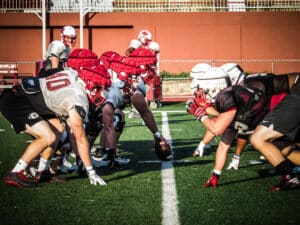
Each coach has their own style and variation when drawing plays, and these are some of the common methods they follow.
Start by sketching your formation to show how each play develops and all positions clear. Use straight or curved arrows to show the direction of a run.
Keep the paths simple enough that players can follow them at full speed. Here’s a quick method:
- RB runs: solid lines with arrows
- Motion players: dashed lines
- Cutbacks: curved or jagged arrows
Use arrows with jagged lines
When drawing routes for receivers, use arrows to mark exact breaks and turns. Show sharp cuts with 90° angles and deep routes with long, straight arrows.
Blocking assignments
The offensive line sets the tone for every play. Show blocking with short lines pointing toward the defender’s side.
Use symbols like X for defenders and arrows with perpendicular lines at the end from linemen to mark who they block.
Coaches can use notes sections of their playbook to add descriptions of blocking responsibilities. Here’s a simple table for clarity:
| Position | Blocking Direction | Notes |
| LT | Left edge rusher | Seal outside |
| LG | Defensive tackle | Hold gap |
| C | Nose guard | Snap then block |
| RG | Defensive tackle | Double team if needed |
| RT | Right edge rusher | Push wide |
How to Add Variations and Adjustments
You can strengthen your football plays by adding small changes that keep opponents guessing. Adjust motion, timing, or assignments to fit different situations without starting over.
Motion and shifts
Use motion to create new looks from the same base play. Move a receiver across the formation before the snap to test coverage or force a defender to adjust.
Shifts can change the strength of your formation, giving your offense another angle. Here are some benefits:
- Identify man vs. zone coverage
- Create mismatches in space
- Force defenders to communicate quickly
Audibles and hot routes
An audible lets you change the play at the line when you spot a defensive break. A hot route gives a receiver a quick adjustment, like a short drop and turn, if extra pressure comes.
These tools help you react to what the opponent does in real time. Some common adjustments:
- Switch from run to pass
- Add a quick slant or hitch
- Protect against blitzes
Timing and film study
Timing matters with variations. A late motion or slow route break can throw off the whole play.
Practicing at game speed keeps everything sharp. Film study helps you spot opponent tendencies so you can attack weak spots.
Draw Plays With GoRout’s Free Playbook Template
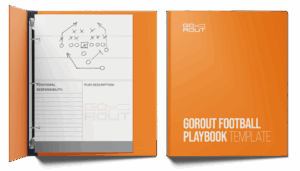
Here’s how GoRout’s free football playbook gives you tools and structure to up your game on the field.
GoRout’s template delivers a polished, professional layout with space for X’s and O’s, positional roles, audibles, motions, and coaches’ play notes so your team is aligned and clear about every assignment.
You’ll get space to draw plays for offense, defense, and special teams, including run, short and deep pass concepts. That lets you sketch out and rehearse multiple scenarios ahead of game day.
Whether you’re a rookie coach or a seasoned play-caller, this template saves time, standardizes your playbook, and helps communicate your strategy clearly. It’s beneficial for practice planning and in-game adjustments.
Fill out the form on the GoRout page, wait up to a minute to get the PDF in your inbox. Then print or use digitally. The layout is flexible enough for bulk print or screen use.
How to Use Digital Tools for Football Play Drawing
Digital tools make drawing, editing, and sharing football plays easy. You can view plays instantly, tweak them in seconds, and keep your team on the same page.
Most of these tools are user-friendly, so you don’t need to be a tech expert.
Web-based play designers let you build plays right in your browser. Drag-and-drop symbols for players and routes make it simple to create a full football playbook.
With football playbook software, you can organize plays, search for formations, and update strategies quickly. Some perks:
- No software to install
- Easy to share with players
- Access from any device
Video analysis with drawing
Some tools let you overlay routes and assignments on video clips. Players can see how a play looks in real game situations.
Combining video with diagrams connects strategy to actual movement. It’s a big help for learning fast.
Presentation and drag-and-drop tools
You can use PowerPoint with drag-and-drop shapes and add arrows to make clean diagrams for team meetings.
Modern football coaching apps even let you share updates instantly, so your players always have the latest playbook version during the entire season.
How to Draw Football Plays with GoRout Scout

GoRout Scout lets you turn your drawn plays into quick, efficient football practice reps.
Instead of passing out paper cards to your team, you just upload any image file or PDF document via the web app and build scripts from there.
Then, you can send encrypted play calls straight to your players’ wrist practice devices using the mobile app.
| Feature | How It Helps You |
| Script builder | Arrange plays in any order for practice |
| Instant updates | Send changes on the fly without printing |
| Wearable devices | Players view plays clearly in any weather |
| Cloud backup | Keep your digital playbook safe and ready |
You don’t actually draw plays inside GoRout Scout. Instead, you import files from tools you already use, like Hudl or Visio.
https://www.youtube.com/watch?v=M8829aqS-Cc
Once you’ve uploaded everything, you can script plays in any order you want. Push them instantly to your team with a tap.
It makes your playbook easier to run and update. Practice keeps moving without the usual slowdowns.
No WiFi is needed since the devices use a cellular-based system. Your sessions stay connected wherever you practice and work, regardless of weather conditions or environment.
Common uses include:
- Running more plays with scout teams
- Walkthroughs with offense or defense
- 7 on 7 drills and special teams reps (KO, KOR, P, PR)
- Preparing against fast-paced opponents
- Quick installs for freshmen or transfers
If you’re interested in in-game use, check out GoRout Gridiron.
If you use this football play-calling system, you cut wasted time and reduce confusion. Your team gets more reps and clearer communication, all while keeping your strategies secure.
GoRout Scout packages start as low as $1,700.
Get a quote today for a personalized offer.
Collaboration and Communication: Building a System Together
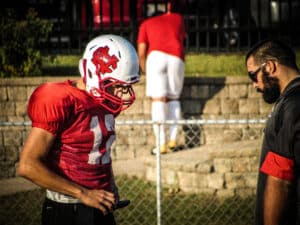
You set the tone for how your team communicates. A clear system helps players understand plays faster and keeps confusion down.
Coach-to-player communication systems, such as GoRout, make play calls more efficient during practices and games.
When you plan, focus on consistency. Decide how you’ll signal plays, review films, and share feedback.
A simple, repeatable process builds trust and keeps everyone on the same page.
Key steps for coaches:
- Watch films to spot trends and adjust your playbook.
- Use sideline signals or digital tools for quick communication.
- Review each game with clear notes for improvement.
Player involvement
Your players need to feel part of the process. When they help design plays or review films, they learn why each assignment matters.
This shared responsibility builds accountability and a stronger sense of community. Encourage players to ask questions and give feedback.
A team communication app can help keep everyone connected during practice.
Ways to involve players:
- Assign film review tasks by position groups.
- Let leaders suggest adjustments during game planning.
- Create small groups to test new play ideas.
Common Football Play Drawing Mistakes to Avoid
When you draw football plays, small mistakes can limit their effectiveness. Clear, simple diagrams are essential if you want your players to actually run the plays correctly.
Overcomplication
One key mistake is adding too many moving parts. If your play looks crowded with arrows and shifts, players may get confused.
Keep routes and assignments simple so your team can focus on execution, not decoding the diagram.
Ignoring player capabilities
Another mistake is drawing plays without considering your players’ skills.
For example, asking a slow lineman to pull across the field or a receiver to run a deep route they can’t handle will hurt your results.
Always match assignments to what your players can realistically do. It makes your playbook more practical and reliable.
Lack of testing
Drawing a play is only the first step. If you don’t test it in practice, you won’t know if it really works. Test every new design in practice before adding it to your playbook.
Conclusion on How to Draw Football Plays
Now you’ve got the hang of breaking down football strategy into easy diagrams. By figuring out formations, symbols, and movement lines, you can sketch out plays that your team will get and can actually use on the field.
A strong playbook gives you three main benefits:
- Clarity: Everyone knows their role
- Consistency: Plays stay organized and repeatable
- Flexibility: You can adjust to defenses faster
When you practice drawing plays, focus on keeping them simple and easy to read. Even the most advanced strategies fall apart if players can’t follow the diagram or if the design looks confusing.
If you want to take your play design further, digital tools can help. Programs like Hudl let you create, share, and even animate plays for better communication with your team.
For real-time play calling, GoRout Scout stands out as the best system. It delivers plays instantly to players through digital wristbands, cutting out delays and miscommunication. It makes your practice time more efficient and your game-day execution sharper.
If you’re ready to improve your coaching and streamline your play calling, consider getting a quote from GoRout. It’s a simple step that can make your playbook more effective and your team more prepared.
FAQs on How to Draw Football Plays
Where can I draw football plays for free?
You can use free online tools like Football Play Card or browser-based whiteboards to sketch plays without cost. Google Slides and PowerPoint also work well if you want a simple setup.
These options let you drag, drop, and adjust player icons quickly.
What is the best program to draw football plays?
If you want advanced features, dedicated apps like Hudl provide professional-level tools to create plays. For youth or casual use, PowerPoint, Google Slides, or even Microsoft Word are enough.
Pick based on your needs, whether it’s basic diagrams or full playbook management.
How do you draw football players easily?
Start with simple shapes. Use circles for players and arrows for movements.
Keep symbols consistent so your team understands the diagram at a glance. Over time, you can add details like blocking paths or coverage zones.
How to create a football playbook?
Start by gathering your plays in one document. Use slides, PDFs, or just printed sheets, whatever feels right.
Try organizing them by formation, situation, or play type. Some coaches lean on digital playbook software to store and share plays, but honestly, Word or Google Docs work fine too, and they’re free.

